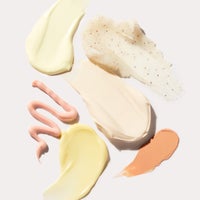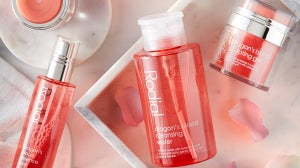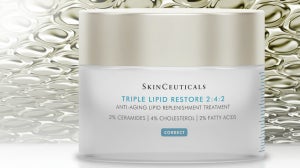
The pursuit of baby-smooth, glowing skin is a never-ending one, but considering all the beating your skin gets from everyday environmental stressors, this often seems easier said than done. But what if it doesn’t have to be? By knowing how to exfoliate skin the right way—and choosing the best exfoliators for different skin types and needs—you will be well on your way to rocking that coveted radiant, healthy-looking skin!
Table of Contents:
- What is exfoliation?
- What are the different types of exfoliants?
- How often should you exfoliate?
- What exfoliant is best for each skin type?
- How to exfoliate your face
- What are the risks of exfoliation?
What is exfoliation?
Exfoliation refers to the process of removing dead cells from the surface of your skin. While your skin naturally sheds these old skin cells every 28 days, the aging process can slow down cell turnover significantly. This causes dead skin cells to linger on the topmost layer of your skin and build up over time. When you factor in product residue and daily grime, your skin could end up looking dull, dry and ashy. And if that’s not bad enough, letting dirt and debris pile up on your skin’s surface can also clog your pores—and we all know what that leads to: acne.
What are the different types of exfoliants?
Exfoliation can be done in two ways: physically, with a scrub, or chemically, using peels, toners, masks and cleansers. Here are the top things to remember about physical and chemical exfoliants.
Physical exfoliants
Also known as mechanical exfoliation, physical exfoliation requires the use of tools (such as cleansing brushes, sponges or washcloths) and a face scrub with fine abrasive granules (like ground pearls, beads, seeds or nutshells, salt and rice) to manually lift and remove dead skin cells. Skincare treatments like microdermabrasion and dermaplaning also fall under physical exfoliation.
Chemical exfoliants
Meanwhile, chemical exfoliation is the process of breaking down and sloughing off dead skin cells on the topmost layer of the skin using acids or enzymes. These chemicals—alpha hydroxy acids (AHAs), beta hydroxy acids (BHAs) and fruit enzymes—work by melting away and loosening the connections between cells and dissolving the sugars in the skin, making it easier to slough off dead skin cells and encouraging the growth of new, healthier cells.
Combination exfoliants
As the name suggests, combination exfoliants utilize both physical and chemical exfoliators in one product, usually in the form of face washes. Combination exfoliators will typically contain both common exfoliating enzymes and fine granules.
How often should you exfoliate?
If you’re new to exfoliation, you may be tempted to do it as frequently as possible. After all, why wait for tomorrow when you can get clear, glowing skin today? However, over-exfoliation—which can occur when you’re doing it too often or using a product that’s too harsh—will only serve to fast-track your skin to dryness and irritation.
As a general rule, you should start with a gentle exfoliant once or twice a week, and slowly work your skin up to more frequent exfoliation, if necessary. Once your skin has acclimated to the process, you can use physical exfoliants two to three times a week, while chemical exfoliants should be limited to once a week for dry or sensitive skin and up to three times for other skin types. Combination exfoliants can be used once weekly or daily, depending on the product’s formula and recommendations.
Other skincare products, like serums and moisturizers, can also contain ingredients with exfoliating properties. These can be used in combination with your exfoliator, depending on your skin’s needs, label recommendations, and your doctor’s advice.
It’s worth remembering, however, that having more than one exfoliating product in your daily routine may be more than your skin can handle. So, it’s always best to consult with your dermatologist before adding and combining exfoliators.
What exfoliant is best for each skin type?
As important as it is to have a regular exfoliation routine, using the wrong exfoliant for your skin type can do more harm than good. Some skin types may not be able to tolerate big granules while others do fine with extra fine beads. There are also specific skin concerns that are better addressed with chemical exfoliators. Here is a complete guide on what to exfoliate with for your skin type:
Dry or sensitive skin
Dry skin types are more at risk of over-exfoliation as the lack of proper moisture can make the skin weaker and susceptible to microtears and lesions. Instead of reaching for a scrub, opt for gentle chemical exfoliants and limit the procedure to one to two times a week.
The same can be said for those with sensitive skin, who wish to reap the benefits of exfoliation without subjecting their skin to redness and irritation. Instead of peels, which can be harsh on sensitive skin, opt for mild and creamy washes formulated with AHAs, such as glycolic, mandelic and lactic acids. These work best for dry or sensitive skin as they can gently dissolve unwanted surface debris while also helping your skin retain moisture.
Oily or acne-prone skin
Oily skin can typically handle more frequent exfoliation, which is perfect as having overactive oil glands means your skin is also dealing with excess sebum and other oil-based impurities. Manual or physical exfoliation three to four times a week can help remove that extra layer of skin-dulling debris and grime sitting on the surface of your skin.
However, if you are currently experiencing a breakout, you’ll want to skip the scrub and reach for a chemical exfoliator instead. Inflamed skin can be further irritated by abrasive grains, so it’s best to switch things up with acne fighting AHAs and BHAs. These can remove those acne-causing dirt and bacteria lingering deep in your pores as well as help prevent and repair acne-related scarring.
Another option for those with breakout-prone skin is retinol, a powerful ingredient with exfoliating properties that hastens skin cell renewal while shedding off dead skin cells and pore-clogging debris.
Mature skin
Regular exfoliation can help encourage cell renewal, making it an important part of your daily routine if you have mature skin. This will also allow your anti-aging products to be absorbed more efficiently by your skin.
Mature skin can benefit from both physical and chemical exfoliation. If you don’t want to keep switching between two products, try a combination exfoliator that is formulated with extra-fine granules and gentle AHAs or BHAs. You can go the extra mile and look for added anti-aging and moisturizing ingredients, such as antioxidants, hyaluronic acid and ceramides.
Combination skin
Having combination skin means you have the option of using either physical or chemical exfoliants or both as long as you’re not using them at the same time. If your skin tends to be on the dry side, however, it’s best to opt for products formulated with hydrating ingredients so as not to aggravate or over strip your skin.
Normal skin
Physical, chemical or combination exfoliants can all work well for normal skin. Finding the right product is only a matter of trial and error and picking out the one that works best with your skin.
How to exfoliate your face
Exfoliation is a straightforward process, but as simple as it is, things can easily turn disastrous for your skin when it’s done incorrectly. Below is a step-by-step guide on how to exfoliate the face using physical, chemical and combination exfoliators.
Chemical exfoliators
Step 1: Start by washing your face with your go-to face cleanser and pat skin dry with a clean towel.
Step 2: Apply a small amount of the product (or as suggested by the label) to the skin. Using clean fingers, gently spread the product over your face with small, circular motions. Make sure to avoid your eye area.
Step 3: Rinse off the product or leave it on the skin as instructed on the label. Exfoliating face washes or cleansers can be washed off after a minute or two. If you’re using a chemical peel, make sure you follow package instructions carefully. Leaving them on for longer than recommended may cause some redness, sensitivity, itching or peeling.
Physical exfoliators
Step 1: Prep your skin by washing your face with a gentle cleanser using lukewarm water. Or better yet, exfoliate while you’re taking a warm shower. Running lukewarm water on your skin for a few minutes before exfoliating can help open and prime your pores for cleaning. Just make sure the water is not too hot to avoid leaving your skin feeling dry.
Step 2: With a pea-sized amount of your preferred exfoliator, dot your forehead, both cheeks and chin. Using your hands or a soft sponge or washcloth, spread the exfoliant across your face with gentle, circular motions, taking care to avoid the eye area. Make sure to keep your movement light and not rubbing or tugging on your skin. Do this for at least 30 seconds to a minute.
Step 3: Rinse off the product with warm water and pat skin dry. Follow up with your favorite moisturizer or hydrator.
Combination exfoliators
Step 1: Cleanse and prep your skin with a face wash using lukewarm water.
Step 2: Dispense a small amount of the product and spread it across the face using small, gentle and circular motions. Combination exfoliators often come with their own specific instructions as to how long they need to sit on your face, so make sure to follow those carefully.
Step 3: Rinse the product off with warm water and apply moisturizer immediately after.
What are the risks of exfoliation?
As essential as exfoliation is to your skincare routine, there can be too much of it. In some instances, over-exfoliation can occur when you’re using a product more frequently than recommended or that’s too harsh for your skin. This can lead to redness, drying and irritation.
Using the wrong type of granules in physical exfoliants and rubbing too hard on your skin can also lead to microtears. These microscopic lesions can be caused by grains that are too abrasive or too big. Dirt and bacteria can enter your skin and cause infection and irritation. It’s also best to hold off on exfoliating if you have a cut or wound on your skin, sunburn or skin infections.
Exfoliating with more than one product at a time can also lead to skin irritation, dryness and damage. Skip your exfoliating face wash and cleansing brush when you’ve already done a face peel, and especially when you’ve undergone treatments like microdermabrasion.
Shop all exfoliants & scrubs at SkinStore to promote radiant and softer skin.

Related Articles







